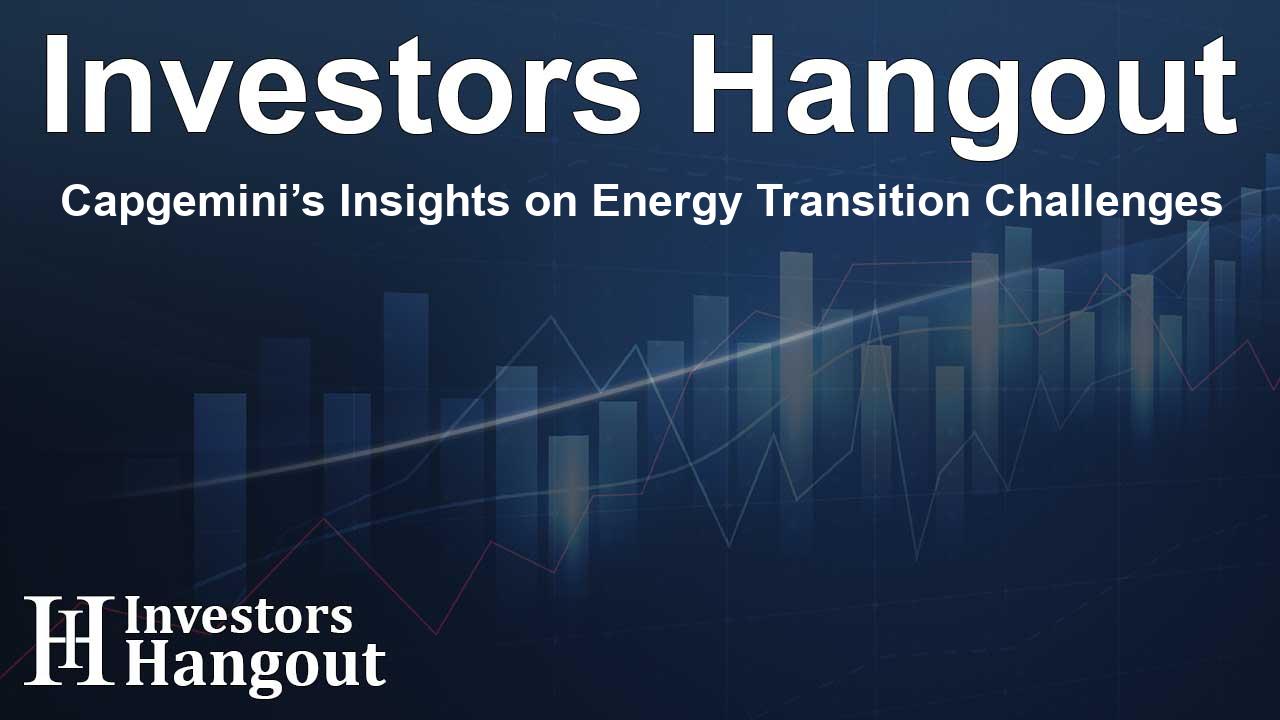Capgemini’s Insights on Energy Transition Challenges

Capgemini’s World Energy Markets Observatory Annual Report Highlights
The latest edition of Capgemini’s World Energy Markets Observatory (WEMO) reveals critical insights regarding the challenges faced in the global energy sector. Although there have been notable improvements in renewable energy development, the report underscores that the pace remains insufficient. Urgency is required to meet the goals of the Paris Agreement, emphasizing that enhanced efforts will be necessary to achieve net-zero emissions.
Acceleration Needed for Renewable Energy Transition
While 2023 saw remarkable progress in renewable energy, with a recorded increase in total capacity, the overall growth is still not adequate. The global renewable energy supply is predicted to cover only about 40% of total energy demands by 2050. This deficiency calls for expedited deployment of renewable technologies, particularly in developing nations, to hit the decarbonization targets set for 2030 and beyond.
Growth Statistics
According to the report, renewable energy capacity surged by 14% year-over-year in 2023, mainly driven by solar energy's impressive growth of 32%, outpacing wind energy's 13% increase. Nevertheless, this is far from what is required to achieve the ambitious net-zero goals set for 2050.
Nuclear Energy and Its Role in Clean Energy Demands
The report also highlights the renewed focus on nuclear energy as a cornerstone for meeting future low-carbon energy requirements. Current global nuclear capacity holds a crucial 9% share in electricity generation, providing 25% of the low-carbon electricity worldwide. However, achieving a stable and expanded nuclear presence faces challenges due to the complexity of developing new power plants and the slow progress of Small Modular Reactors (SMRs).
Strategic Importance of Hydrogen
In parallel, hydrogen has emerged as a pivotal player in the decarbonization strategy. The number of hydrogen projects making significant developments has quadrupled, pointing to its increased potential, particularly in industries where emissions are hard to mitigate. The emphasis on applying hydrogen in difficult-to-abate sectors, such as heavy industry, is now stronger than ever.
Investment in Power Grid Infrastructure
The transition towards clean energy is heavily reliant on the modernization of power grid infrastructures. Investment in grid upgrades is expected to reach approximately USD 400 billion in upcoming years. Innovations in artificial intelligence for electricity consumption forecasting are anticipated to enhance grid management significantly.
Challenges of AI Adoption
Although AI holds promise in facilitating energy transitions, current challenges persist, particularly a lack of skills necessary for its deployment. The integration of AI, particularly Generative AI, is considered essential in improving grid efficiency and developing new energy solutions.
Need for Effective Market Mechanisms
To solve the energy transition’s complexities, the establishment of innovative market mechanisms is essential. These mechanisms should amplify both public and private investments in low-carbon technologies, which are critical for a successful energy transition. Moreover, evolving from a primary energy assessment to focusing on final energy demand will provide a clearer picture of progress made in clean energy initiatives.
Conclusion and Future Steps
In conclusion, Capgemini’s WEMO report serves as a stark reminder of the urgent need for more decisive action in the energy sector. With greenhouse gas emissions on the rise and critical milestones ahead, the path to achieving net zero remains steep. Comprehensive and collaborative efforts, alongside the adoption of new technologies and innovative approaches, will be vital in transforming the energy landscape and realizing the goals set forward in international agreements.
Frequently Asked Questions
What is the main focus of Capgemini’s 2024 report?
The report reviews the current energy transition scenario, emphasizing the urgency of enhancing renewable energy deployment and investment.
How significant was the increase in renewable energy capacity in 2023?
Renewable energy capacity increased by 14% in 2023, with solar energy growing faster than wind.
What role does nuclear energy play according to the report?
Nuclear energy is recognized as crucial for providing stable, low-carbon electricity amidst rising clean energy demands.
Which emerging technology is increasingly viewed as a strategic lever in decarbonization?
Hydrogen is now considered a strategic component of decarbonization, particularly in hard-to-abate sectors.
How can AI contribute to the energy transition?
AI can enhance grid efficiency and help in developing new energy technologies, but challenges in adoption exist.
About Investors Hangout
Investors Hangout is a leading online stock forum for financial discussion and learning, offering a wide range of free tools and resources. It draws in traders of all levels, who exchange market knowledge, investigate trading tactics, and keep an eye on industry developments in real time. Featuring financial articles, stock message boards, quotes, charts, company profiles, and live news updates. Through cooperative learning and a wealth of informational resources, it helps users from novices creating their first portfolios to experts honing their techniques. Join Investors Hangout today: https://investorshangout.com/
Disclaimer: The content of this article is solely for general informational purposes only; it does not represent legal, financial, or investment advice. Investors Hangout does not offer financial advice; the author is not a licensed financial advisor. Consult a qualified advisor before making any financial or investment decisions based on this article. The author's interpretation of publicly available data shapes the opinions presented here; as a result, they should not be taken as advice to purchase, sell, or hold any securities mentioned or any other investments. The author does not guarantee the accuracy, completeness, or timeliness of any material, providing it "as is." Information and market conditions may change; past performance is not indicative of future outcomes. If any of the material offered here is inaccurate, please contact us for corrections.